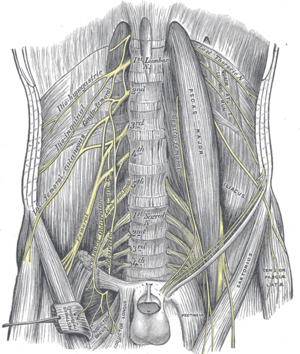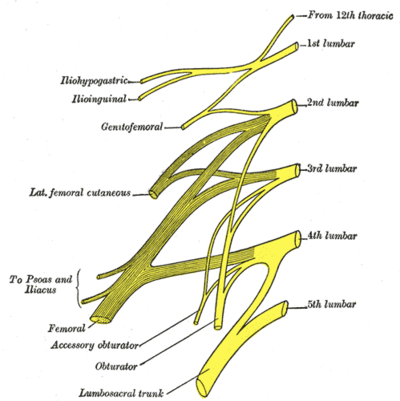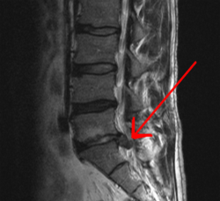Lumbar Plexus: Difference between revisions
Kim Jackson (talk | contribs) No edit summary |
Kim Jackson (talk | contribs) No edit summary |
||
| Line 13: | Line 13: | ||
== Origin and Location == | == Origin and Location == | ||
The origin of the lumbar plexus is within the [[Psoas Major|psoas major muscle]], anterior to the lumbar transverse processes. The dorsolumbar nerve, which joins the anterior ramus of spinal nerve L1, contributes to the creation of the lumbar plexus via the anterior ramus of spinal nerve T12. The iliohypogastric and ilioinguinal nerves are derived from a single trunk formed by these roots (T12, L1). The anterior rami of L1 and L2 each have a branch that | The origin of the lumbar plexus is within the [[Psoas Major|psoas major muscle]], anterior to the lumbar transverse processes. The dorsolumbar nerve, which joins the anterior ramus of spinal nerve L1, contributes to the creation of the lumbar plexus via the anterior ramus of spinal nerve T12. The iliohypogastric and ilioinguinal nerves are derived from a single trunk formed by these roots (T12, L1). The anterior rami of L1 and L2 each have a branch that merge to form the genitofemoral nerve. | ||
== Nerves == | == Nerves == | ||
Revision as of 10:08, 29 April 2022
Original Editor - Carla Benton
Top Contributors - Carla Benton, Kim Jackson, Admin, Laura Ritchie, Libby McConnell, Lucinda hampton, Evan Thomas, WikiSysop and Carina Therese Magtibay
Introduction[edit | edit source]
The lumbar plexus is a complex neural network formed by the lower thoracic and lumbar ventral nerve roots. They are formed where T12 to L5 exit the spinal cord via intervertebral foramina. The supply motor and sensory innervation to the lower limb and pelvic girdle[1].
The nerves arising from the lumbar plexus are important for functioning of the lower extremity function and movement allowing knee extension, hip flexion and adduction of the thigh[2].
Origin and Location[edit | edit source]
The origin of the lumbar plexus is within the psoas major muscle, anterior to the lumbar transverse processes. The dorsolumbar nerve, which joins the anterior ramus of spinal nerve L1, contributes to the creation of the lumbar plexus via the anterior ramus of spinal nerve T12. The iliohypogastric and ilioinguinal nerves are derived from a single trunk formed by these roots (T12, L1). The anterior rami of L1 and L2 each have a branch that merge to form the genitofemoral nerve.
Nerves[edit | edit source]
The lumbar plexus allows nerves to combine at different levels to create multiple functioning nerves that serve to innervate various structures. The nerves that arise from the lumbar plexus are listed below, from superior to inferior.
- The iliohypogastric nerve is created from spinal levels T12 and L1. Motor innervation: internal oblique muscle; transverse abdominal muscles. Sensory inputs: lateral gluteal area.
- The ilioinguinal nerve derives from a branch of the L1 spinal nerve. Sensory inputs: anterior superior and medial parts of the thigh; males, the distal portions of the nerve become the anterior scrotal nerve that inputs sensory fibers to the root of the penis and the superior part of the scrotum; females, the distal portions of the nerve are the anterior labial nerves that help to provide sensory inputs to the skin covering the mons pubis and the labia majora. Motor inputs: internal oblique muscle; transverse abdominal muscles.
- The genitofemoral nerves arise from the superior aspects of L1 and L2 spinal nerves. The nerve separates into the genital and the femoral branch. Genital branch supplies the cremaster muscle and scrotal skin in men and supplies sensory to the mons pubis and the labia majora in women. Genitofemoral nerve's femoral branch provides sensory innervation the anterior, superior area of the thigh.
- The lateral femoral cutaneous nerve comes from the L2 and L3 spinal nerves. Singular function of supplying sensory innervation to much of the lateral portion of the thigh.
- The obturator nerve arises from L2, L3, and L4 spinal nerves. It provides the primary motor supply to the medial (adductor) muscle compartment of the thigh. [2].
- The femoral nerve ranks as the largest nerve that arises from the lumbar plexus. It is created from lumbar spinal nerves L2, L3, and L4.
To remember the major branches of the lumbar plexus why not use this useful Mneumonic?
| Interested | In | Getting | Lunch | On | Friday |
|---|---|---|---|---|---|
| Iliohypogastric | Ilioinguinal | Genitofemoral | Lateral femoral cutaneous | Obturator | Femoral |
Physiotherapy Implications[edit | edit source]
Damage to the lumbar plexus or nerves proximal and distal to it can result in several pathologies.
- Lumbar disc herniation can result in occlusion of the intervertebral foramen, which can compress lumbar spinal nerves proximal to their entrance to the lumbar plexus. This condition can result in paresthesia and weakness of the areas innervated by nerves of the lumbar plexus.
- Commonly, peripheral nerves and the lumbar plexus can suffer damage due to trauma.
A common and significant nerve compression syndrome can arise from the lateral femoral cutaneous nerve, which is a branch of the lumbar plexus.
- This syndrome is called meralgia paresthetica and is caused usually by entrapment of the nerve as it passes under, or through the inguinal ligament.This condition can present as a painful syndrome involving the anterolateral area of the thigh. Non-steroidal anti-inflammatory drugs (NSAIDs), narcotics, and anti-neuropathic pain medications can be used to treat this condition.
It is crucial as physical therapists to have a strong knowledge base and understanding of the lumbar plexus in the treatment of our orthopedic patients.
- In order to accurately determine the cause of our patients' pain or dysfunction, analyzing which level is affected can help us to make better intervention choices, which in turn will create better outcomes.
- Patients presenting with only lower extremity deficits may be initiated from the lumbar plexus, and not the extremity.
- Being able to utilize our anatomy and physiology in treating our patients with musculoskeletal dysfunctions can help our patients progress more effectively and quicker, which will help decrease costs of extended treatment due to misdiagnosis.
- Applying this anatomy with our patients who receive spinal blocks and epidurals can also help us determine the most effective treatment approach and better understand our patient's presentation in the clinic[3].
References[edit | edit source]
- ↑ Radiopedia Lumbar Plexus Available from:https://radiopaedia.org/articles/lumbar-plexus (last accessed 14.9.2020)
- ↑ 2.0 2.1 Singh O, Al Khalili Y. Anatomy, Back, Lumbar Plexus. In: StatPearls. StatPearls Publishing, Treasure Island (FL); 2019.Available from:https://www.ncbi.nlm.nih.gov/books/NBK545137/ (last accessed 14.9.2020)
- ↑ Lumbar nerve plexus Website. Available at http://www.medical-look.com/human_anatomy/organs/Lumbar_nerve_plexus.html/. Accessed November 19, 2009.









